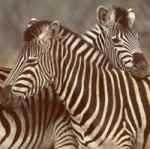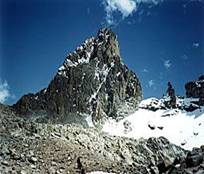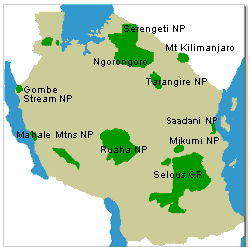|
The park is also an ornithologists paradise with more than 300 species of birds, including the largest bird in the world, the ostrich and the heaviest bird that can fly, the Kori Bustard.
The best game viewing months are between September and December but for bird viewing is is best to come between the months of October and May
SELOUS GAME RESERVE
The Selous Game Reserve, located approximate 8 hours drive south of Dar-es-Salaam, is the largest reserve in Africa and one of the largest protected wildlife areas in the world. It is home to some of the biggest quantities and variety of animals and birds in Africa. It has the world's largest number of big game, more than 120,000 elephants, 160,000 buffaloes and about 2,000 rhinoceros, In addition, the Selous contains Africa's greatest concentration of hippopotamus, crocodile and wild dog. The Selous is a rare combination of woodlands, marshes, savannah and open grass plains, crisscrossed by many rivers, one being the mighty Rufiji River.
The best time to visit is from June to the end of October. The park can be reach by road, rail for air, having several airstrips located at the various camps, a flight from Dar-es-Salaam takes approximately 45 minutes.
RUAHA NATIONAL PARK
Situated in the centre of the country, the Ruaha National Park, is Tanzania's second largest park covering an area of over 13,000 sq kms and the worlds largest elephant sanctuary. Although set in spectacular scenery, with an abundance of wildlife, the park is one of the lesser visited in the country, keeping it an isolated, peaceful and unspoilt wilderness.
Amongst the game found here are Elephant, Buffalo, Giraffe, Cheetah, lion, leopard, a wide variety of antelope including the Greater and Lesser Kudu and the Roan and Sable antelopes. There is over 465 recorded species of birdlife in the area.
The best time for game viewing is during the dry season when the animals congregate along the Ruaha River, from between May and December. During the raining season, from January to April, many roads are impassable.
TARANGIRE NATIONAL PARK
Located approximately 110 kms southwest of Arusha, covering an area of approximately 2,600 sq kms. During the dry season from June to October, this park has a particularly high concentration of wildlife, mainly congregating along the Tarangire River.
The park is also an ornithologists paradise with more than 300 species of birds, including the largest bird in the world, the ostrich and the heaviest bird that can fly, the Kori Bustard.
The best game viewing months are between September and December but for bird viewing is is best to come between the months of October and May
NGORONGORO CRATER
The Conservation area is a fine blend of landscapes, people, wildlife and Africa main archaeological site, lying in the north of country and merging into the Serengeti Game Reserve. The Ngorongoro Crater is regarded as a natural wonder of the world (the 8th) and has been declared a World Heritage Site. It is the largest intact crater in the world, being 610 meters deep, 16 kms across and covering an area of 540 sq kms. and is teaming with wildlife, with virtually all the big game species found here, including, zebra, wildebeest, black rhino, antelope, elephants, giraffe, buffalo, lion, cheetah, leopard. The area is also an ornithologists' paradise, with the thousands of flamingos wading in the shallows of Lake Magadi and hundreds of other species of birdlife.
The prime time of the year to visit is from December to May when the spectacular sight of the Serengeti migration usually takes place.
 |
Visit the famous volcanic Ngorongoro crater which is the largest unbroken caldera in the world. There are 25,000 larger animals within the crater including Zebra and wildebeest, lion, , leopard, cheetah, hyena, elephants, warthog, impala, buffalo, hartebeest, eland and smaller mammals of sorts.
We have whole selection of itineraries, ranging from sheer luxury to budget participation camping safaris, offered through different tour operators.
|
MIKUMI NATIONAL PARK
Mikumi National Park is located approximately 300 km west of Dar es Salaam, and is a popular destination for weekend visitors. The park lies within a flood plain bordered by the Uluguru Mountain range to the east and the Rubeho Mountains on the west and covers an area of over 3,200 sq kms.
Wildlife is abundant with giraffe, zebra, buffalo, hartebeest, wildebeest being amongst the most commonly sighted game, but elephant, wild dog and tree climbing lions are also found here along with smaller mammals and reptiles. The park is also home to over 300 different species of birds.
Access to the park is easy, with good road conditions from Dar es Salaam, and an airstrip near the park headquarters.
Accommodation:-
There is a variety of accommodation available ranging from budget to luxury and a tented camp with designated camp sites. Advance bookings are advisable. LAKE MANYARA NATIONAL PARK
Location: 130KM west of Arusha
Best time to visit: Dry season (July-October) for large mammals; wet season (November-June) for bird watching, the waterfalls and canoeing. Size: 325 km² (of which about 230 km² are the lake)
Sights: Lake Manyara NP is in base of the Great Rift Valley escarpment and comprises of forest, woodland, grasslands, and swamps. Wildlife to be spotted Tree climbing Lions, Baboons, Buffalo, Zebra, Hippos, giraffe; Wildebeest, and over 350 species of bird, storks and flamingoes. MAHALE MOUNTAINS NATIONAL PARK
Located in the west of the country, Muhale Mountains National Park is a remote park that can only be reach by plane or boat. There are no roads and game viewing is safely carried out on foot.
This is the other of Tanzania's parks where chimpanzee can still be found in their natural habitat along with elephant, buffalo, antelope, giraffe, leopard and lion.
The best time of the year to visit is between May and October.
Accommodation
Camping is allowed in designated areas and camping equipment is available for hire. SAADANI NATIONAL PARK
anzania's newest national park, located 130 km North of Dar Salaam and just 38 km from Zanzibar.
The reserve has the unique distinction of being East Africa's only coastal wildlife sanctuary, providing the opportunity to observe Africa's big game and bird life interacting with the sea. Saadani has a diverse population of mammals and birds, although many species are both scarce and scared compared to other parks which have received better protection in the past.
Of the big five, lion, leopard, elephant and buffalo are present, the rare Roosevelt sable is indigenous, whilst plains game such as giraffe, zebra, wildebeest, eland and hartebeest are more frequently seen in larger herds.
The southern boundary is marked by the Wami River, which attracts fabulous bird life, large pods of hippo, massive crocodiles and the spectacular black and white Colobus monkey. Bottle-nosed dolphins are common off the Southern coast of the reserve, whales pass through the Zanzibar Channel in October and November, and there is a green turtle breeding beach at Madete in the North. GOMBE STREAM NATIONAL PARK
This park is located in the north-western part of the country, just 16 kms north of Kigoma. It is Tanzania's smallest parks, covering an area of 52 sq.kms, but one of the most popular, famous for its chimpanzees, being one of the few remaining places where they can be found in their natural habitat.
Due to the park being heavily forested, large game animal are not found in this area, but the park is home to a number of different species of monkey including the red colobus, red-tail and blue monkey, grey duiker, bushbuck and bushpig as well numerous species of bird including trumpter hornbills, Roos's turaco, crowed eagle, secretary bird, narrow tailed starling to mention a few.
The park can only be accessed by boat and a daily entry permit is charged.
Accommodation:
There is a small hostel in the park where beds and mattresses are provided and all provisions including cooking equipment should be brought with you. Booking in Kigoma is recommended.
Kilimanjaro is the highest mountain in Africa, reaching a height of 5,895 meters, a dormant volcano, with the diameter at its base being 40 miles. There are two main snow capped peaks, Kibo and Mawenzi. Although it can be climbed year round the best times of the year for climbing are between August and October and January and March, from mid March to May it is the wet season.
There are six different routes up the mountain ranging in degree of difficultly and there are many tours operators running organised trips.
The Park has been a game reserve since 1921 and was designated a National Park in 1973. The rainforest is home to many species of animals and birds including, leopard, rhino, elephant, buffalo. |
|
|


 Virtually every game species in Africa can be found here, but it is most famous for its vast herds of wilderbeest, zebra and antelope, as well as "the Serengeti Lions"
The best viewing months are from December to March, when many animals are concentrated in the park's southern regions.
However, one of the spectacular and unique events of the year is the Serengeti annual migration, which takes place heading north to south October November and back south to north between the months of April and June. This has been described by many as one of the greatest wonders of the world. There is no fixed migration timetable, the animals migrate according to rainfall patterns.
Virtually every game species in Africa can be found here, but it is most famous for its vast herds of wilderbeest, zebra and antelope, as well as "the Serengeti Lions"
The best viewing months are from December to March, when many animals are concentrated in the park's southern regions.
However, one of the spectacular and unique events of the year is the Serengeti annual migration, which takes place heading north to south October November and back south to north between the months of April and June. This has been described by many as one of the greatest wonders of the world. There is no fixed migration timetable, the animals migrate according to rainfall patterns.